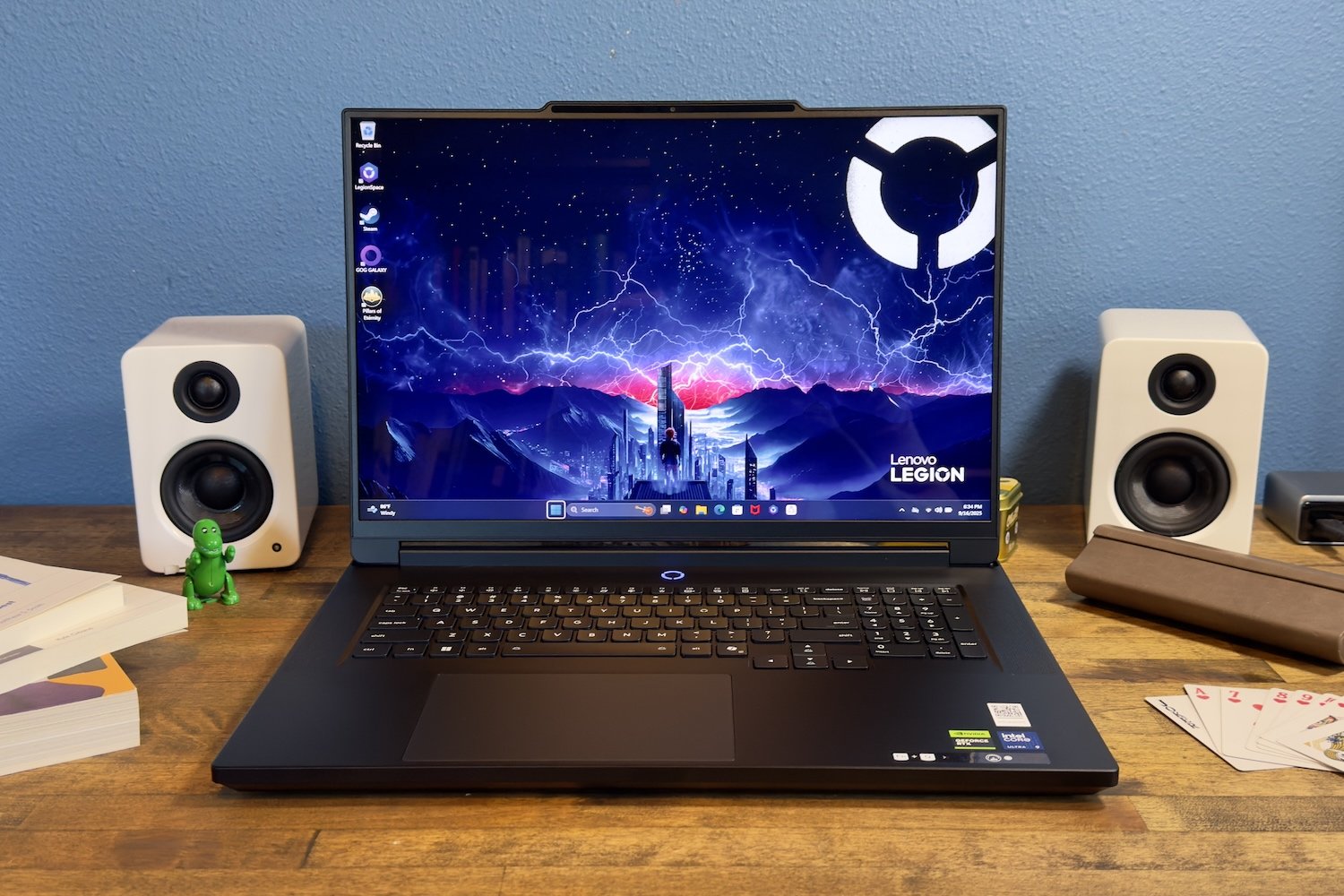At a glance
Expert’s Rating
Pros
- Eye-catching exterior design
- Enjoyable keyboard, large touchpad
- Tons of leading-edge connectivity
- Strong GPU performance in games
Cons
- Modest display quality with questionable 1200p/440Hz mode
- CPU performance doesn’t measure up
- Short battery life
Our Verdict
The Lenovo Legion 9i packs great game performance in a stylish design, but it comes with a few caveats.
Price When Reviewed
This value will show the geolocated pricing text for product undefined
Best Pricing Today
Best Prices Today: Lenovo Legion 9i
Gamers who want a stylish laptop are likely to love Lenovo’s new Legion 9i. It has an eye-catching “forged carbon” look that’s unique yet not overdone. The laptop also packs great game performance and a wide range of physical connectivity. However, the laptop’s display and CPU performance don’t match up to peers, which narrows its appeal.
Lenovo Legion 9i: Specs and features as-tested
The Lenovo Legion 9i that I received for review was equipped with impressive hardware. It has not only an Intel Core Ultra 9 275HX and Nvidia RTX 5080, but also 64GB of RAM and a 2TB PCIe 5.0 solid-state drive, not to mention Thunderbolt 5 and USB-C 4.
The only specification that isn’t impressive is the display, which, though it provides a sharp 3840×2400 resolution, relies on a mediocre IPS-LCD panel.
- Model number: 18IAX10
- CPU: Intel Core Ultra 9 275HX
- Memory: 64GB SO-DIMM DDR5-5200
- Graphics/GPU: Nvidia RTX 5080 16GB (175W TGP)
- NPU: Intel AI Boost up to 13 TOPS
- Display: 18-inch 3840×2400 glossy IPS with 240Hz refresh rate, G-Sync
- Storage: 2TB PCIe 5.0 M.2 SSD
- Webcam: 5MP with electronic privacy shutter
- Connectivity: 1x HDMI 2.1 (8K/60Hz), 2x USB-C with Thunderbolt 5 and USB-4 80Gbps, DisplayPort, 100-watt Power Delivery, 1x USB-C 10Gbps / USB 3.2 Gen 2, 3x USB-A 10Gbps / USB 3.2 Gen 2, 1x 3.5mm combo audio, 1x 2.5GbE Ethernet, 1x SD card reader, 1x power connector
- Networking: Wi-Fi 7, Bluetooth 5.4
- Biometrics: Facial recognition
- Battery capacity: 99 watt-hours
- Dimensions: 15.87 x 11.69 x 1.1 inches
- Weight: 7.72 pounds
- Operating System: Windows 11 Home
- Price: $3,695.49 MSRP
The Lenovo Legion 9i starts at $3,476.99 with 32GB of RAM and 1TB of solid state storage. Lenovo’s upgrade pricing is incredibly affordable. Moving up to 64GB of RAM and a 2TB SSD adds only $220 to the MSRP.
Lenovo provides a “Naked-Eye 3D” display option in some Legion 9i laptops. This is a glasses-free 3D technology similar to Acer’s SpatialLabs. My review unit didn’t have this display, however, and instead came with a dual-mode display that supports 240Hz at 3840×2400 resolution or 440Hz at 1920×1200 resolution.
Lenovo Legion 9i: Design and build quality
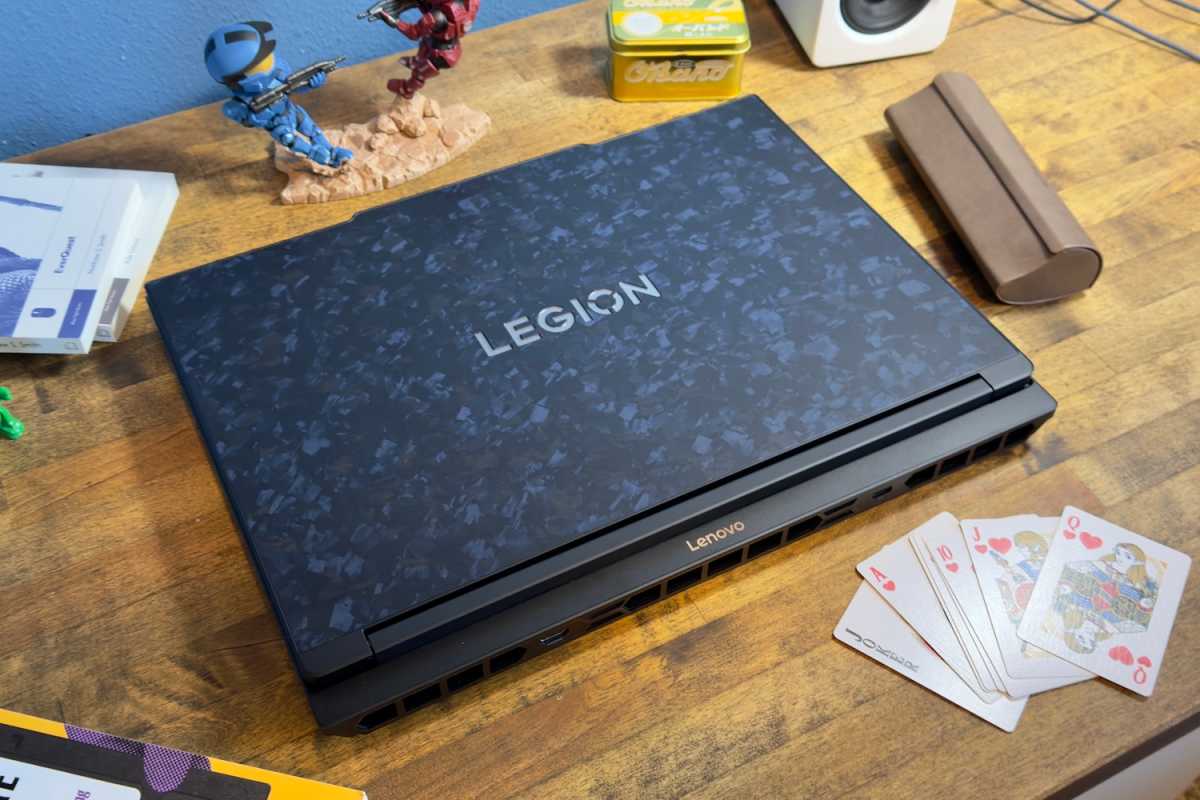
Foundry / Matthew Smith
Look, I’m about to tell you what I think about the Lenovo Legion 9i’s design. But before I do, take a moment to look at the photos. I’ll wait.
It looks glorious, right?
There’s nothing unusual about how the Legion 9i’s design functions, as I’ll discuss shortly. But Lenovo’s unique lid design, which the company calls “forged carbon,” is a winner. It’s attractive and fashionable, but not in-your-face or garish. It’s a design statement, and I like what it says.
Overall, the laptop both looks and feels premium, and most of Lenovo’s competitors are a full step behind.
That aside, the Legion 9i delivers what I expect from a high-end performance gaming laptop. It’s a beefy machine that measures over 15 inches wide, over an inch thick, and tips the scales at nearly eight pounds. The recycled aluminum chassis is extremely rigid. Flex can be found in the display lid and keyboard deck, but you’ll have to pay attention to spot it.
Overall, the laptop both looks and feels premium, and most of Lenovo’s competitors are a full step behind. Even attractive competitors like the Alienware Area-51 strike me as old-fashioned compared to the Legion 9i.
Lenovo Legion 9i: Keyboard, trackpad, mouse
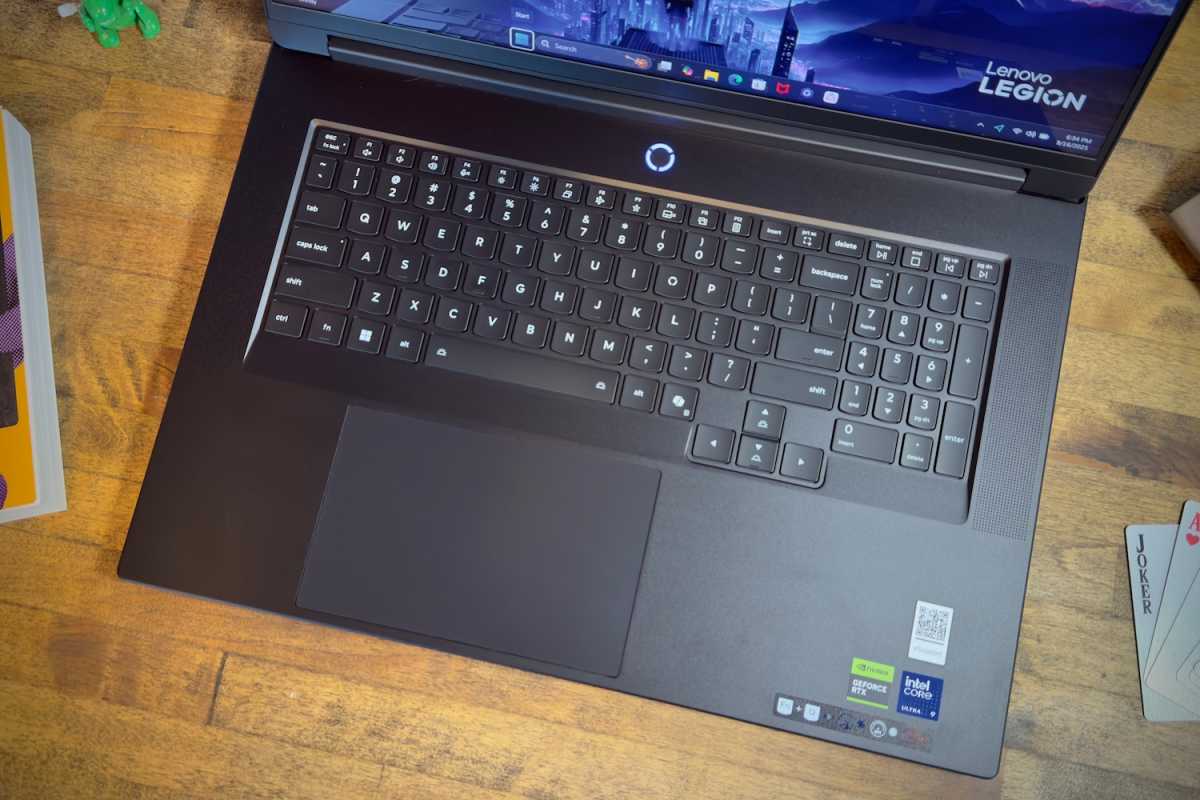
Foundry / Matthew Smith
Typing on the Lenovo Legion 9i is a great experience. The keyboard provides good key travel and each key activates with a light yet satisfying tactile snap. Lenovo provides a good layout, too. Most keys are large, with only the backspace key and the numpad key feeling a bit narrow—though they’re still large enough.
The keyboard is RGB-LED backlit and provides per-key lighting customization, although you might not know that at first. The per-key customization is only visible when the “custom” mode is selected from a list of presets in Lenovo’s Legion Space software. The LED backlight is bright, uniform, and offers a wide range of brightness suitable for both dim and bright rooms.
Lenovo also packs an RGB-LED light bar on the front underside of the chassis, and RGB-LED lights across the Legion logo for the lid, which can coordinate with the keyboard. I like the lightbar, which provides a subtle gradient between LED light zones that creates the illusion of a single uniform light rather than multiple, individual LEDs. The Legion 9i supports Windows Adaptive Lighting as well, though support must be turned on in the laptop’s BIOS.
The included numpad means the keyboard is shifted towards the left, and the touchpad follows. The touchpad itself is sizable at about six inches wide and four inches deep. You can find larger touchpads on some competitive laptops, like the Razer Blade 18, but the Legion 9i has no shortage of room for executing Windows’ multi-touch gestures.
I also found the touchpad responsive and didn’t have problems with unintended inputs. A physical mouse button action is available by pressing on the lower half of the touchpad. It does the job, but it’s rather subtle and activates with a dull thud instead of a snappy click.
While the Legion 9i’s keyboard and touchpad aren’t perfect, they’re a strong point when compared to alternatives. The Razer Blade 18 has a good keyboard and bigger touchpad, but its RGB-LED lighting options are not as impressive. Alienware’s Area-51 also has a good keyboard, and some decent RGB-LED lighting, but the touchpad is modest. The Legion 9i delivers more than competitors overall and avoids downsides.
Lenovo Legion 9i: Display, audio
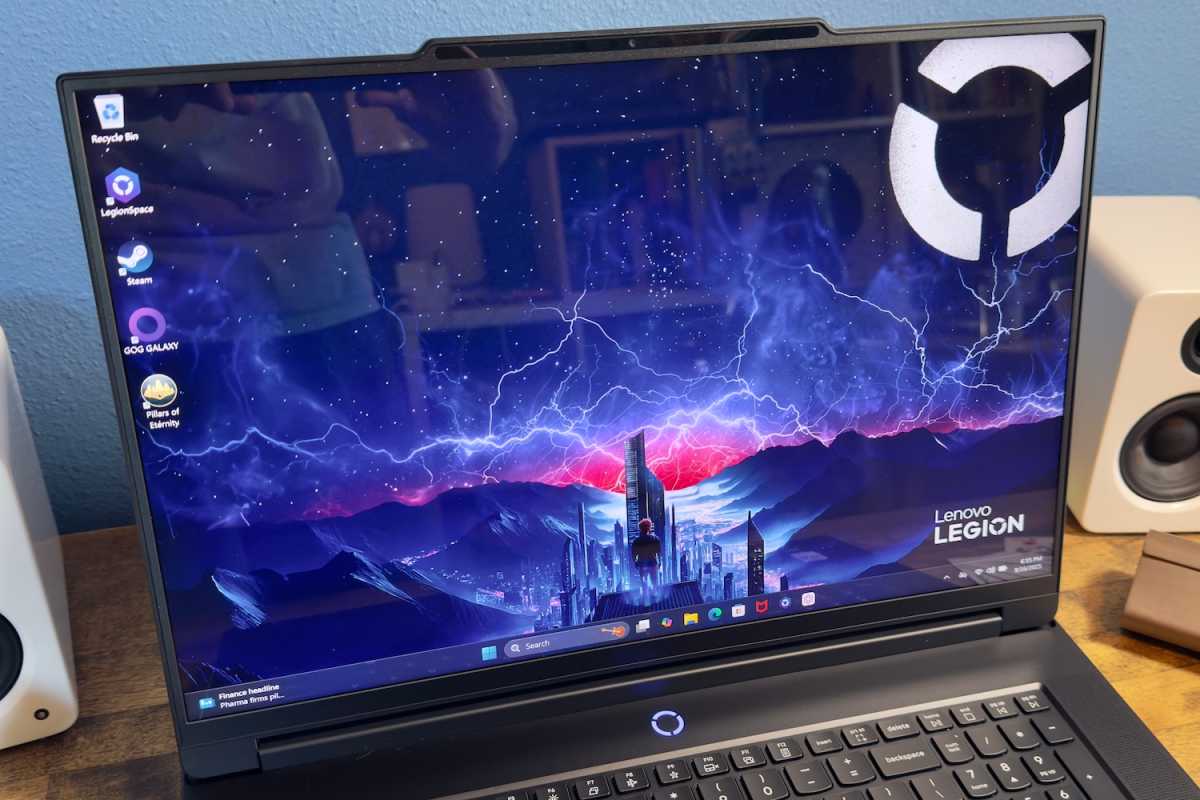
Foundry / Matthew Smith
The display is the Lenovo Legion 9i’s only obvious weakness, but it’s a big one. It falls short in display quality and makes a half-hearted attempt to deliver ultra-high refresh rates.
Let’s talk refresh rate first. The Legion 9i’s 18-inch display supports a refresh rate up to 240Hz at a resolution of 3840×2400. Alternatively, it can reach 440Hz at a resolution of 1920×1200.
However, the details of Lenovo’s implementation aren’t great. Users must access BIOS to flip to 1200p/440Hz or back to 2400p/240Hz. That’s an annoying problem, and Lenovo doesn’t do anything to help users mitigate it. The boot screen doesn’t even state the button a user needs to press to access the BIOS. I suspect most people who buy this laptop will use it for years without realizing the 1200p/440Hz mode exists.
Personally, I would never use the feature, anyway. I’d rather stick to 2400p/240Hz, which is already plenty quick, instead of rebooting my laptop to access 440Hz at a lower resolution.
The real problem is not just that the 1200p/440Hz is of questionable use, but also that it means the Legion 9i can’t offer an OLED or Mini-LED display.
The Legion 9i’s IPS-LCD display is a great example of the breed with superb color accuracy, a color gamut that spans 100 percent of sRGB and 99 percent of DCI-P3, and a maximum brightness of 520 nits (I measured up to 519, but what’s a nit between friends?)
However, like most IPS-LCD displays, it has a limited contrast ratio (I measured a maximum of 1340:1). An OLED will deliver far better contrast which leads to a richer and more immersive look. I also noticed the Legion 9i’s display is cool in color tone, with a measured white point of 7,600K at 50 percent brightness. And while the display is bright, it’s also glossy, which means glare is an issue in bright rooms.
Ultimately, the Legion 9i’s display is a miss, but the audio system provides some redemption. Lenovo packs the laptop with two speakers, two tweeters, and two woofers, which together deliver a clear, crisp sound stage and reasonable bass. Quality speakers or a good headset will of course be superior, but the Legion 9i’s sound is enjoyable for a wide range of content, from podcasts to music and games.
Lenovo Legion 9i: Webcam, microphone, biometrics
The Lenovo Legion 9i has a 5MP webcam with an electronic privacy shutter. It’s good, though not exceptional. It provides a sharp and colorful image and handles mixed lighting well, though it’s still obvious that the camera is a webcam. Its quality is comparable to most modern gaming laptops. The microphone is similarly competent, providing good voice capture without the need to raise your voice.
An IR camera is included and provides support for Windows Hello facial recognition. This is a fast, easy way to log in to a Windows machine. But, once again, this is a common feature for a modern gaming laptop. A fingerprint reader is not included.
Lenovo Legion 9i: Connectivity
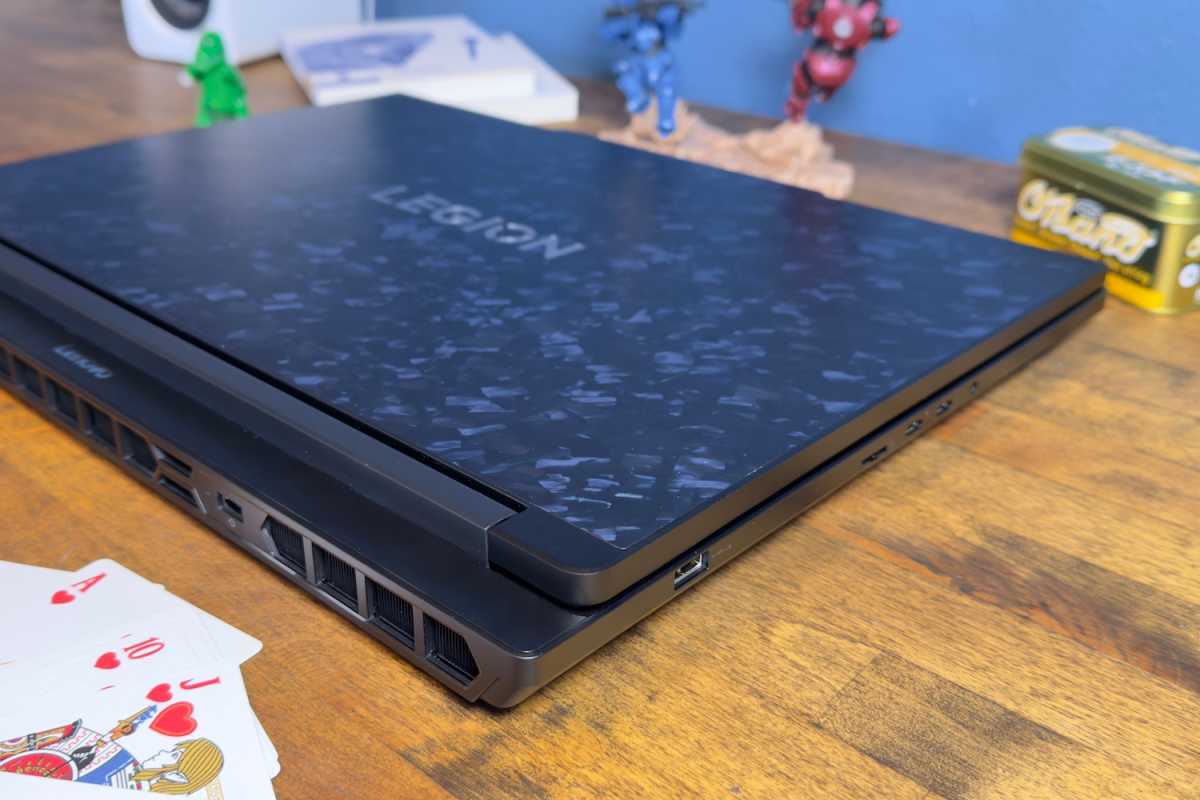
Foundry / Matthew Smith
Lenovo swings for the fences with the Legion 9i’s connectivity, and there’s a lot to dig into.
The star of the show is the laptop’s pair of USB-C ports. They deliver Thunderbolt 5, USB 4 with up to 80Gbps of data, up to 100 watts of Power Delivery, and DisplayPort 2.1. It’s the whole enchilada, or very close to it.
Most modern gaming laptops support Thunderbolt and USB-C, but the Legion 9i offers great support for the latest versions of these standards. That translates to better data rates. If you need high-speed connectivity, or want to connect to a dock or a Thunderbolt / USB-C monitor with numerous downstream ports, these ports are up for the task.
However, the Legion 9i isn’t focused exclusively on Thunderbolt and USB-C. It also provides HDMI 2.1, three USB-A ports, Ethernet, an SD card reader, and a 3.5mm combo audio jack. I have no notes: this is an excellent array of connectivity options.
Wireless connectivity is strong, too, as the laptop supports Wi-Fi 7 and Bluetooth 5.4. These are the latest versions of each standard. It’s standard equipment for a modern gaming laptop, but still good to see.
Lenovo Legion 9i: Performance
The Lenovo Legion 9i has an Intel Core Ultra 9 275HX CPU paired with an Nvidia RTX 5080 GPU. The GPU has a maximum thermal graphics power of 175 watts, which is the most available to the RTX 5080 mobile—though, most other gaming laptops also hit that mark. The Legion 9i has healthy specifications in RAM and storage with 64GB and 2TB, the SSD connects over PCIe 5.0.
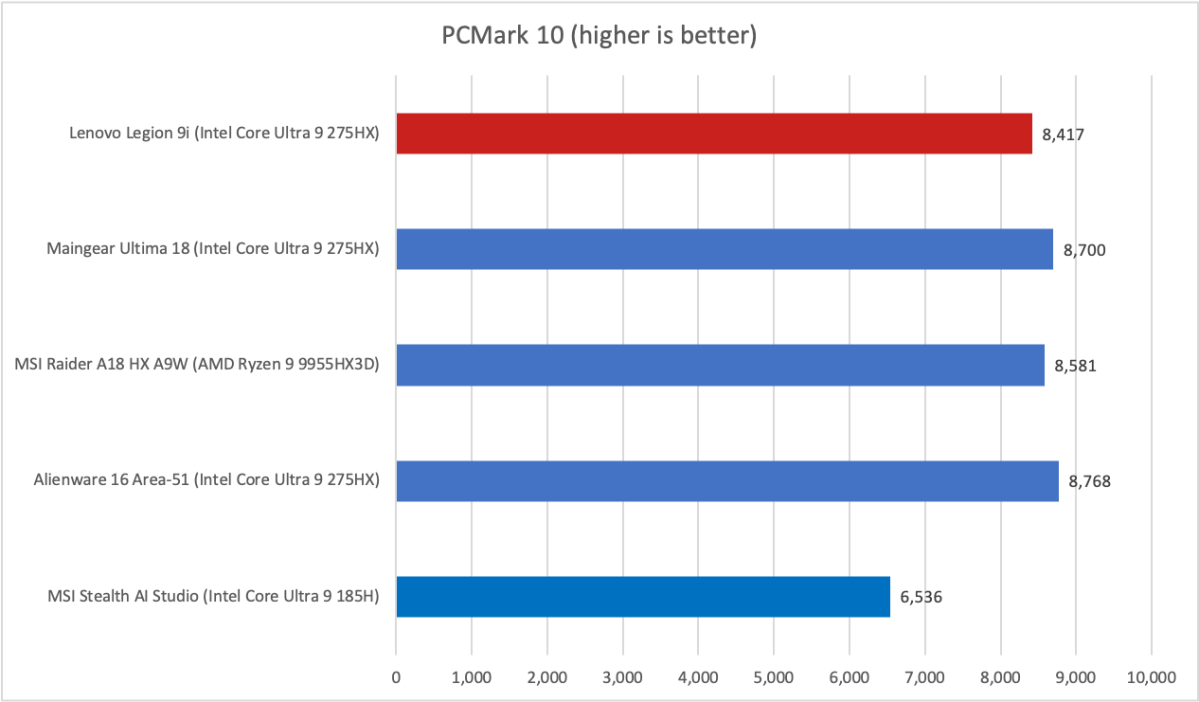
Foundry / Matthew Smith
Our first test is PCMark, a holistic system benchmark. It turned in a respectable score of 8,417. Though this is technically a bit behind some alternative laptops, the margins are thin. I’d say this is more or less a tie between the four top-scoring machines, which includes the Legion 9i.
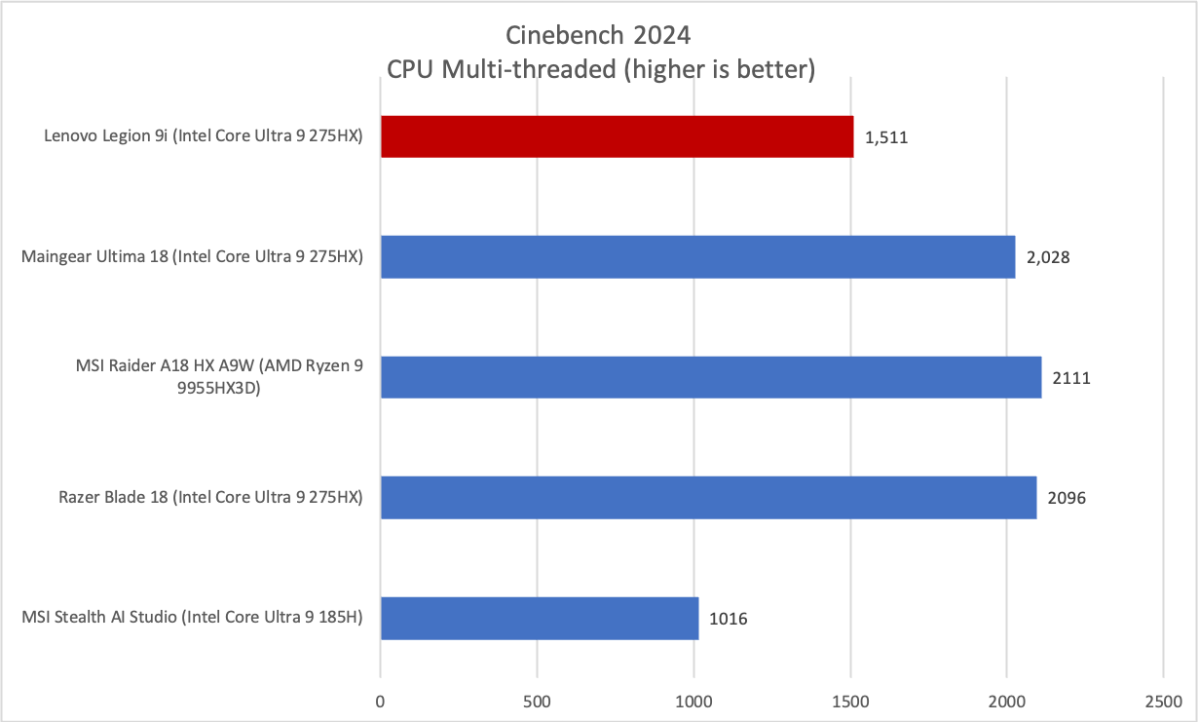
Foundry / Matthew Smith
Next up is Cinebench 2024, a heavily multi-threaded rendering benchmark. Here the Lenovo Legion 9i came up short with a score of 1,511. That’s quick but, as the graph shows, it’s behind a range of laptops that are similar in size and have similar hardware.
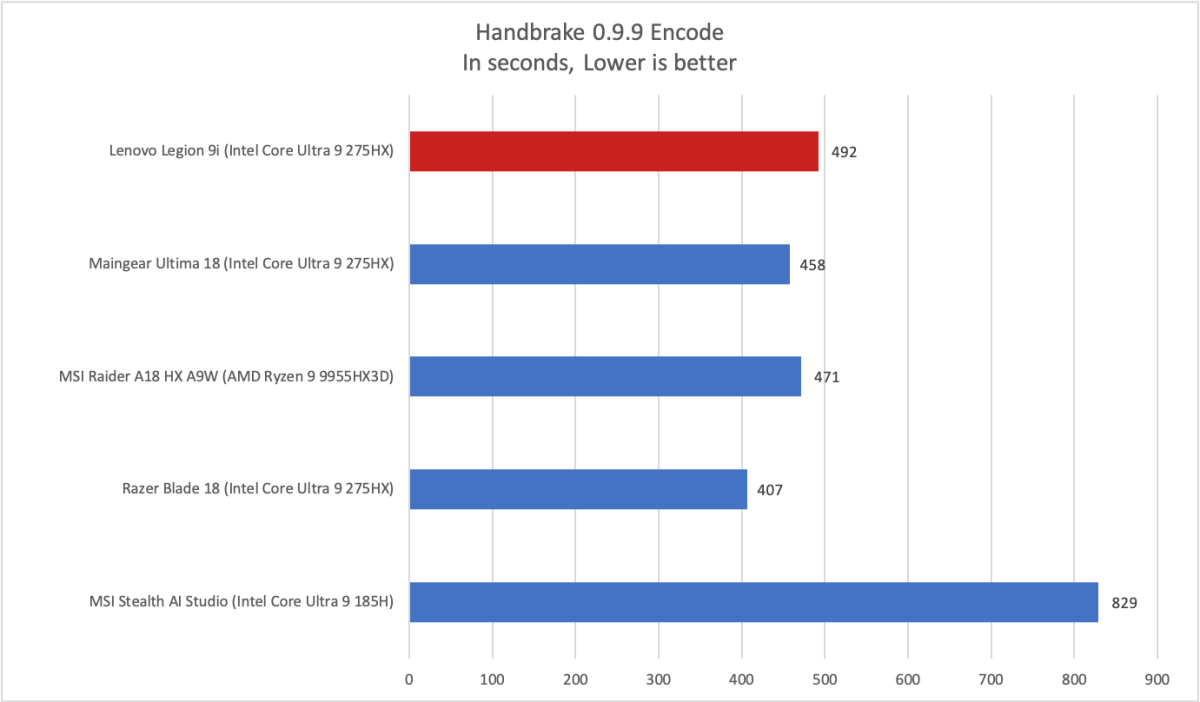
Foundry / Matthew Smith
Handbrake, a heavily multi-threaded video transcoding and encoding tool, also puts the Legion 9i in an unfavorable light. Lenovo’s laptop completed the transcode of a 1080p feature-length film from a .mp4 to .mkv format in eight minutes and 12 seconds. That’s a speedy result, and closer to the competition than in Cinebench 2024. Still, the Legion 9i lags the field.
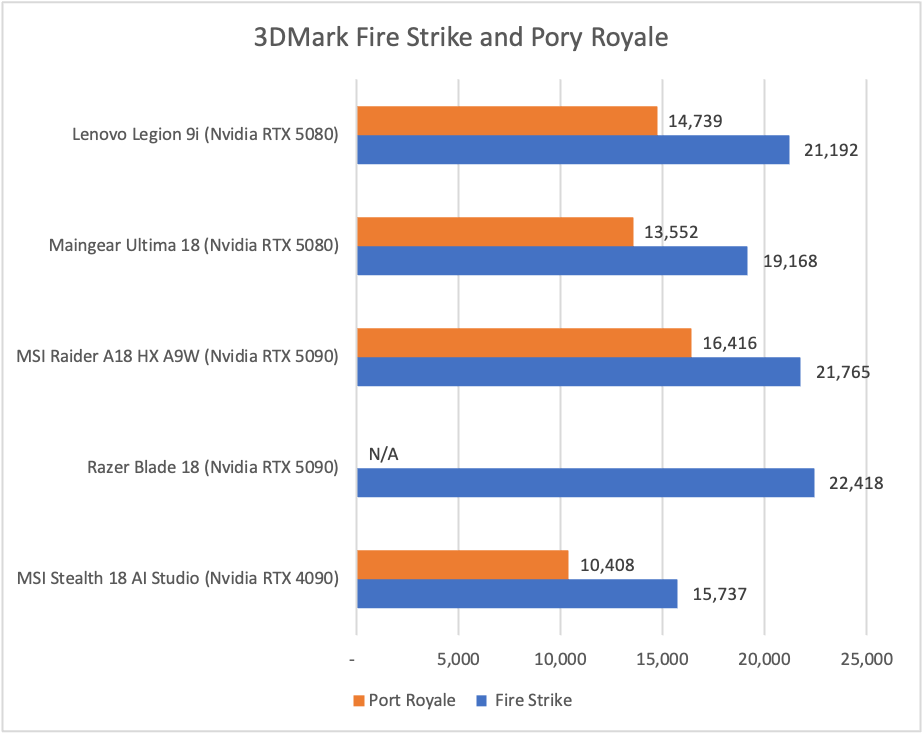
Foundry / Matthew Smith
While the Lenovo Legion 9i struggles a bit in heavily multi-threaded CPU tests, it delivers better results in GPU tests. 3DMark’s Fire Strike and Port Royale tests show the Legion 9i can deliver results that are towards the high end for an RTX 5080 mobile. It’s also not too far off the RTX 5090 mobile.
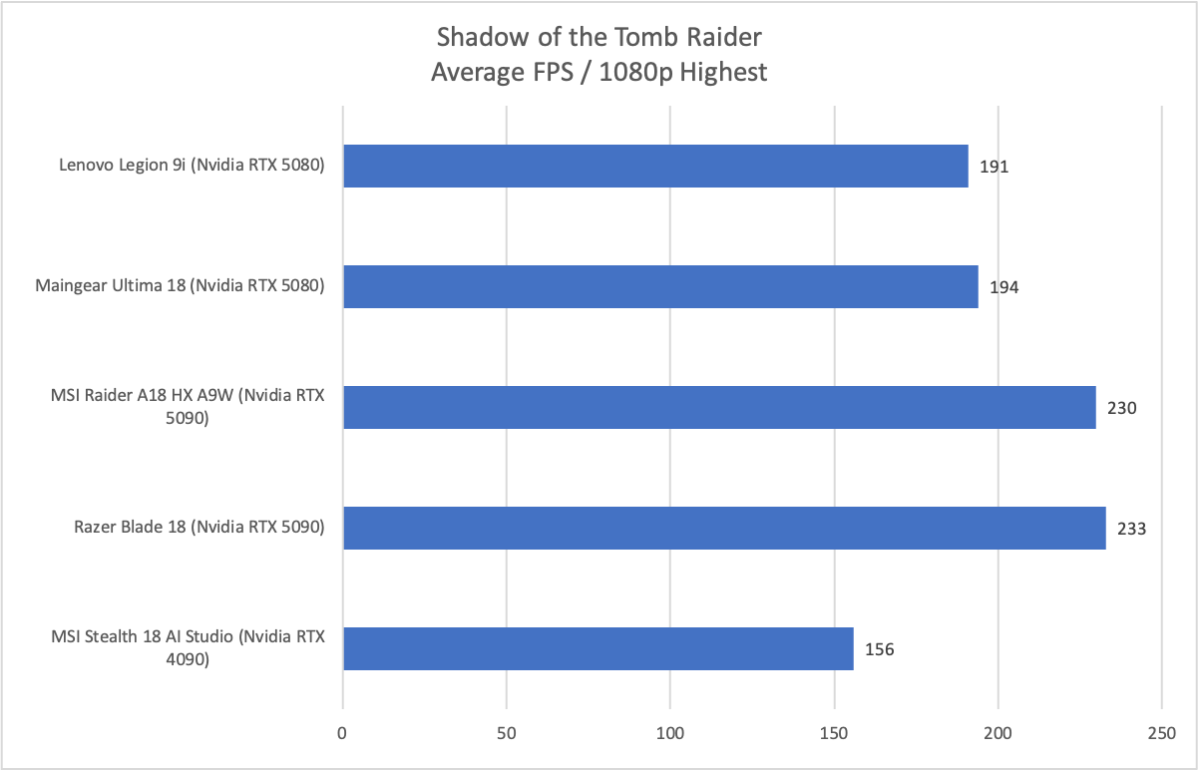
Foundry / Matthew Smith
The performance spread widens a bit in Shadow of the Tomb Raider, an older game that’s not too demanding on newer hardware. The Legion 9i achieved an average of 191 frames per second at 1080p resolution and the Highest detail setting, without use of DLSS or other frame reconstruction. Ray-tracing wasn’t used, either.
As the graph shows, this hits the mark for an RTX 5080 laptop, and can leave some RTX 4090 laptops in the dust. However, the RTX 5090 laptops take a sizeable lead here, as the game’s average FPS is roughly 35 to 40 FPS higher on those machines.
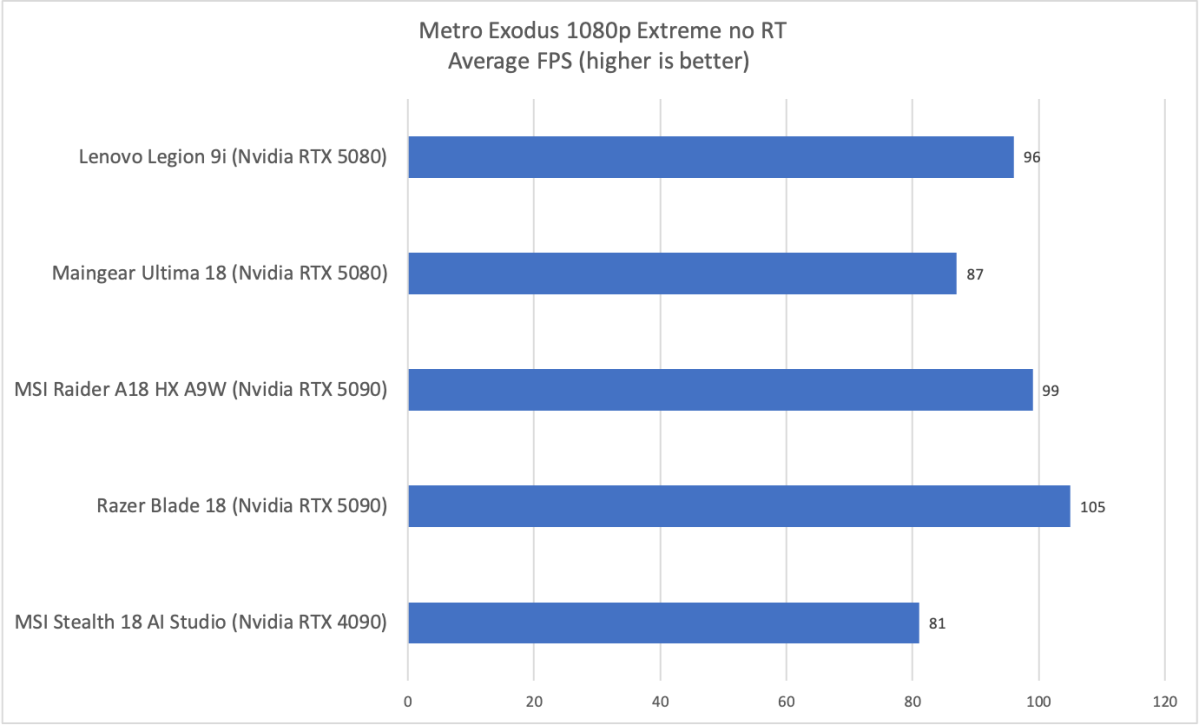
Foundry / Matthew Smith
Metro: Exodus narrows the field again. While this is an older game, and we do not run this benchmark with ray-tracing enabled, it remains a formidable title when the Extreme preset is used. The Legion 9i does well here, scoring between the Maingear Ultima 18 with RTX 5080 and the pair of RTX 5090 laptops.
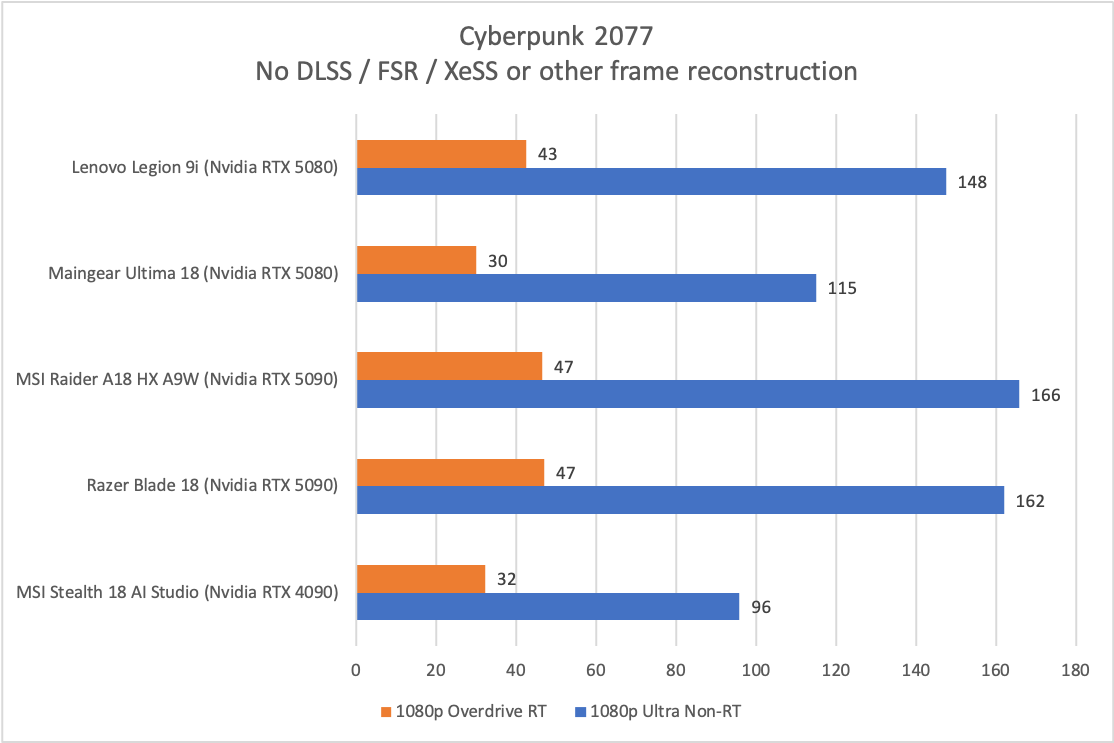
Foundry / Matthew Smith
Cyberpunk 2077 also speaks favorably of the Legion 9i. Here, Lenovo’s laptop can average 148 frames per second at 1080p and the Ultra preset, or 43 at the insanely demanding Overdrive ray-traced preset. Both figures, remember, are without any form of DLSS or frame reconstruction, so in practice better performance is possible.
Still, these numbers stack up favorably. They’re good for an RTX 5080 mobile and not all that far off the RTX 5090 laptops.
On the whole, the Lenovo Legion 9i’s performance seems to favor GPU performance over CPU performance. That leads to solid results in games and somewhat disappointing numbers in heavily multi-threaded CPU tests. On balance the Legion 9i is a fine performer, but it’s definitely tilted towards gaming rather than productivity.
Lenovo Legion 9i: Battery life and portability
The Lenovo Legion 9i has a 99 watt-hour battery. This is the maximum available in a consumer laptop due to limitations on the size of lithium-ion batteries allowed on a passenger airliner.
It’s a very large battery. And the Legion 9i goes to the trouble of supporting Nvidia Optimus, a switchable graphics solution that can turn off the Nvidia GPU (and switch to the Intel IGP) when the GPU isn’t needed.
Still, it’s not enough to deliver great battery life. You can expect anywhere between two and six hours of real-world battery life, depending on how much effort you put into avoiding demanding tasks.
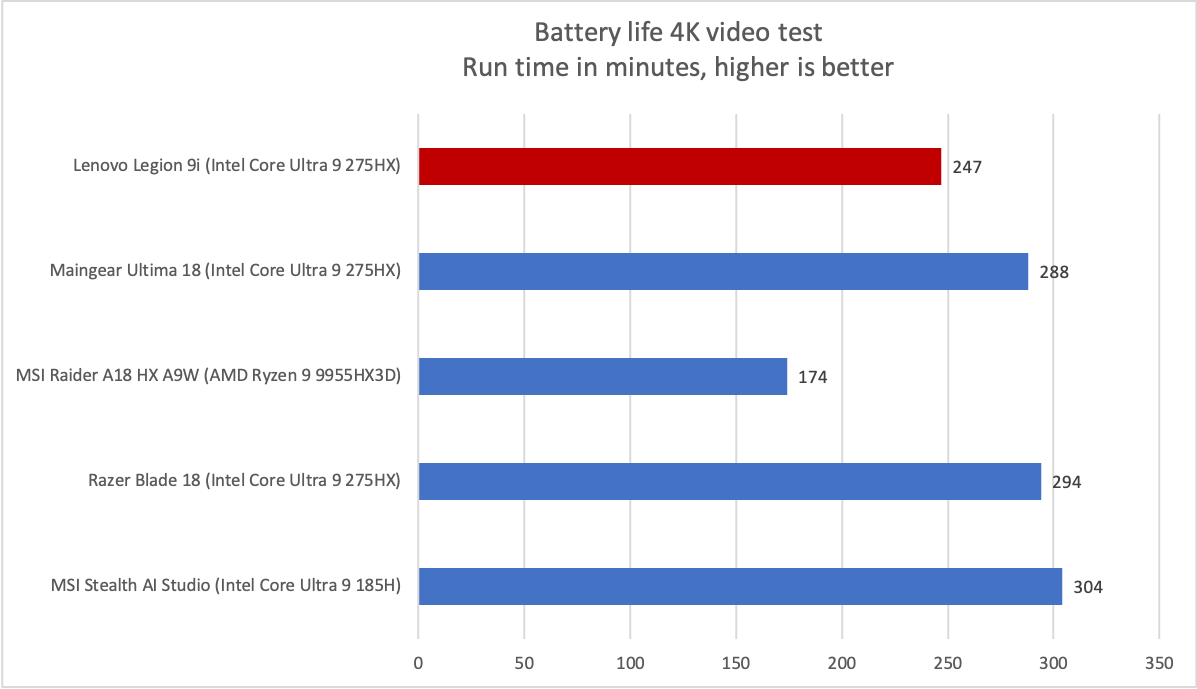
Foundry / Matthew Smith
However, as the graph shows, this is not unusual for a high-end gaming laptop. The fastest laptops tend to land around two to three hours of battery life. Those that do manage to surge ahead, like the Razer Blade, do so with the use of less powerful CPUs and more miserly GPU power configurations.
There’s a clear trade-off here. A modern gaming laptop can deliver maximum performance, or decent battery life, but it can’t provide both. The Legion 9i leans more towards performance.
Lenovo Legion 9i: Conclusion
The Lenovo Legion 9i is a design statement that looks great and proves enjoyable to use day-to-day. It also delivers strong game performance and an incredible array of leading-edge ports. These benefits are countered by a mediocre display with a 1200p/440Hz (or, alternatively, glasses-free 3D) mode that’s of questionable use. CPU performance also fell short of expectations. Still, the Legion 9i is a reasonable choice if you care mostly about GPU performance and will often connect the laptop to an external display.
This articles is written by : Nermeen Nabil Khear Abdelmalak
All rights reserved to : USAGOLDMIES . www.usagoldmines.com
You can Enjoy surfing our website categories and read more content in many fields you may like .
Why USAGoldMines ?
USAGoldMines is a comprehensive website offering the latest in financial, crypto, and technical news. With specialized sections for each category, it provides readers with up-to-date market insights, investment trends, and technological advancements, making it a valuable resource for investors and enthusiasts in the fast-paced financial world.
